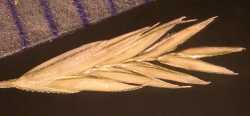Culms 5-110 cm, prostrate (in small circular clumps) to erect. Blades glabrous or scabrous, uppermost blades often exceeding the panicles. Panicles (1.5)10-72 cm long, 4-22 cm wide, with 3-35 branches, usually partially enclosed in the uppermost leaf sheaths; branches 3-12(22) cm, often spreading. Spikelets 5-12 mm. Lower glumes 2-3 mm, lanceolate, sometimes asymmetric; upper glumes 2.5-5 mm, elliptic to ovate; lemmas lanceolate, smoky white at maturity, often with a dark spot on the basal 1/2, apices acute, mucronate, or awned, awns to 3.5 mm; anthers 1-3, 0.2-0.5 mm. Caryopses 0.8-2 mm.
Leptochloa fusca subsp. fascicularis extends from southern British Columbia and Ontario to Argentina, although it has not yet been reported from Georgia. Coastal populations from Massachusetts to Florida with long lemma awns have been called L. fascicularis var. maritima (E.P. Bicknell) Gleason. They do not merit taxonomic recognition because long awns and salinity tolerance are common throughout the species.
Leptochloa fusca subsp. fascicularis differs from L. viscida, which grows in the same region, in its longer panicles, frequently unawned or mucronate lemmas, and whitish florets.
Annual or short-lived perennial tufted herb 5 cm - 1.8 m tall
Leaves: with open, hairless or rough sheaths and membranous ligules that are 2 - 8 mm long, tapering to a slender tip and unevenly cut when mature. The blades are 3 - 50 cm long, 2 - 7 mm wide, tapering to a slender tip, flat, hairless or rough, with the uppermost leaves usually extending above the inflorescence.
Inflorescence: terminal, branched (panicle), 10 cm - 0.7 m long, 4 - 22 cm wide, with the base often surrounded by the leaf sheaths. The three to 35 branches are each 3 - 22 cm long and usually spreading.
Fruit: a caryopsis, 0.8 - 2 mm long, elliptic to egg-shaped or inversely egg-shaped.
Culm: 5 cm - 1.1 m long, prostrate to erect, usually branched, with hollow internodes.
Spikelets: 5 - 12 mm long, usually arranged in two rows on one side of the branch.
Glumes: unequal, membranous, with a rough single vein. The lower glumes are 2 - 3 mm long, lance-shaped and occasionally asymmetric, while the upper glumes are 2.5 - 5 mm wide and elliptic to egg-shaped.
Florets: six to twenty per spikelet, with one to three anthers 0.2 - 0.5 mm long.
Lemma: grayish white and membranous with a dark spot in the lower half, 2 - 6 mm long, lance-shaped with a pointed to stiff-bristled (to 3.5 mm long) or short abrupt tip.
Palea: silky-haired along the veins.
Similar species: No information at this time.
Flowering: mid July to late September
Habitat and ecology: Introduced from the western United States, this common species tolerates salty habitats and grows along toll roads and freeway ramps.
Occurence in the Chicago region: non-native
Etymology: Leptochloa comes from the Greek words leptos, meaning slender, and chloa, meaning grass. Fusca means brown or dusky. Fascicularis means clustered or bundled together.
Author: The Morton Arboretum
Tufted, densely branched from the base, 1-10 dm, procumbent to erect; sheaths smooth or nearly so; blades scabrous, 1-3 mm wide; ligule 2.5-6 mm; panicle subcylindric, 1.5-3 dm נ2-5 cm, with numerous ascending branches; spikelets 5-10 mm, 6-12-fld; first glume narrowly triangular or lanceolate, the second lanceolate or oblong; lemmas 3-5 mm, usually acuminate, short-awned between the 2 minute teeth, pubescent at base and often on the lower part of the veins, the lateral veins often shortly excurrent; grain 1.5-2 mm. Widespread in the warmer parts of N. and S. Amer., especially in brackish or alkaline sites. Three well marked vars. with us, sometimes treated as distinct spp.
Gleason, Henry A. & Cronquist, Arthur J. 1991. Manual of vascular plants of northeastern United States and adjacent Canada. lxxv + 910 pp.
©The New York Botanical Garden. All rights reserved. Used by permission.




